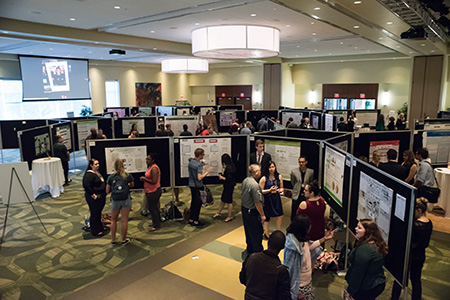Career Resources
Bring your future into focus at the USF School of Art & Art History.
Preparing for a career in the arts is likely a top priority of yours as you embark on your studies. At the School of Art & Art History, you will have an array of opportunities and resources to guide you in your career path.
Learn from top artists and scholars
Engage directly with respected art historians, museum professionals, and artists through the school’s Kennedy Family Artist-in-Residence and Visiting Artists and Scholars program. Graduate students have the additional opportunity of discussing their work with guests when they conduct private studio visits, attend seminars, and deliver demonstrations, an experience that our MFA alumni have described as particularly meaningful and impactful because of the feedback and insight gained. Guests also often hold Friday morning discussions and debates with our graduate students.
Develop professional practices and skills in class
Professional practice courses are embedded right into our curriculum. Studio Art students learn how to approach galleries for exhibitions, how to file taxes, about legal documents such as copyright ownership of artwork, and more. With the help of your instructor and peers, you explore what options are available to visual artists. Our MFA students participate in workshops on writing resumes and CVs, compiling portfolios, and offering mock rehearsals for job interviews. A career preparation course is also in the works for our BA in Art History and BA in Studio Art students.
Receive mentoring and individualized support from faculty
The small student-to-faculty ratio in our classrooms means you will experience individualized attention and more hands-on learning. Our students forge strong mentoring bonds with faculty, acquiring the skills, knowledge, connections, and support to build their careers.
Conduct Research in the Arts
Research in the arts helps develop your conceptual thinking and analytical and communication skills. The BFA and MFA Thesis Exhibitions and Art History Research Symposia are hallmarks of our programs, giving students a chance to present the fruit of their creative investigations with everyone. Visit the College of Design, Art & Performance’ Student Research page for a list of research programs available at USF for both undergraduate and graduate students. Also be sure to regularly check the Opportunities, Awards and Funding page for a list of national and international programs for funding your creative research.
Attain real-world experience
Opportunities for students to gain real-world experience abound at our school.
- Widen your horizons in a study abroad program in Paris, London, Florence or Seoul.
- Mentor at-risk youth through art.
- Intern at local museums and arts organizations.
Whatever you decide to do, you will broaden your perspective and education, all while cultivating proficiency that employers will value.
Career Outlook
Art is essential. Since the beginning of time, people have used art to tell stories, to explore critical issues, and to bring joy and beauty. Indeed, art has the very power to be life-affirming. Your passion for the arts and creativity makes you essential as an artist. By making something that touches the heart and compels the mind, you contribute something very valuable and meaningful to society.
Every year, arts and cultural production contribute significantly to the United States economy. According to the Bureau of Labor Statistics (BLS), employment for craft or fine artists (sculptors, illustrators, painters, etc.) is expected to grow six percent from 2016 to 2026. The median pay for craft and fine artists in 2017 was $49,160 per year, $23.64 per hour.
With the advance of technology and the need for businesses to stay current – —or ahead of the curve— by utilizing their web and digital platforms, demand for internet advertising will increase, thereby increasing the demand for graphic designers, multimedia artists, animators and illustrators as well. Equipping yourself with computer and technology skills will be crucial to landing jobs for online and digital advertising. Such skills will also enable you to promote and sell your work to a wider audience, as online platforms become essential marketing tools, especially for freelance artists.
Continued public interest in the arts, science, and history will contribute to job growth for museum technicians and curators. These positions require specialized skills and advanced levels of education, often at the master’s level or higher. In 2017, the median pay for museum technicians and conservators was $40,670 annually, and, $19.55 per hourly.
Due to a growing demand for animation and visual effects in video games, movies, and television, employment for animators is expected to grow eight percent from 2016 to 2026, per the BLS. The median pay for animators and multimedia artists in 2017 was $70,530 per year, $33.91 per hour.
Employment in the film and video editing field is expected to increase 13 percent from 2016 to 2026, making it one of the fastest growing occupations. The 2017 median pay for film and video editors was $61,180 per year, and for camera operators, it was $53,550 per year. On a related note, strong public demand for film and television entertainment will result in a 12 percent job growth for producers and directors between 2016 and 2026. The 2017 median pay for producers and directors was $71,620 per year, $34.43 per hour.
Engineering, technology, and health care remain rapidly growing fields with high employment growth. Because art is so interdisciplinary, its skills and principles being applicable across a range of occupations, growth in the aforementioned fields impacts job opportunities for artists as well. Artists will be able to contribute to the quality of life for patients in hospitals by designing soothing surroundings. Students interested in combining art with related industries can explore the school’s interdisciplinary Undergraduate Certificate programs.
Information on pay and employment rates retrieved from the Bureau of Labor Statistics.
Careers for Degrees in Studio Art
The creative-thinking and technical skills learned in the studio environment at the USF School of Art & Art History can be translated into a great number of industries. These are a few examples of career paths available to students with Studio Art degrees, but there are many more you can research in the U.S. Bureau of Labor Statistics’ Occupational Outlook Handbook.
2D/3D Computer Animation Artist
3D Renderer/Designer
Advertising Account Executive
Advertising Designer
Animator
Apparel Designer
Art Assistant
Art Directors
Art Handler
Art Teacher (K-12 and University)
Art Therapist
Artisan and Craftspeople
Artist
Arts Manager
Arts Administrator
Broadcast Media Producer
Cake Decorator
Cartoonist
Ceramist
Communications Designer
Concept Artist
Comic Book Artist
Community Arts Program Manager
Costume Designer
Drafting Technician
Entrepreneur
Exhibition Designer
Fashion and Textile Designer
Film/Movie/Theatre Artist (sets, props, design, etc.)
Film Post-Production Artist
Film Special Effects Artist
Filmmaker
Floral Designer
Freelance Artist or Designer
Furniture Designer
Gallery Manager
Game Character Artist
Game Designer
Glass Blower
Graphic Artist
Graphic Designer
Illustrator
Industrial and Product Designer
Interactive Media Designer
Interior Designer
Jeweler
Makeup Artist
Manufacturing Manager
Medical Illustrator
Multimedia Artist
Muralist
Museum Administrator
Museum Curator
Museum Technician
Ornamental Blacksmith
Painter
Sculptor
Photographer
Photographic Retoucher
Photography and Film Technician or Director
Picture Framer
Print Finishing Artist
Printing Technician
Public Relations
Screen Printer
Set Designer
Sign Maker
Sketch Artist
Stone Cutters and Carvers
Storyboard Artist
Theater Exhibit Designers
Toy Designer
UX/UI Designer
Video and Television Specialist
Visual Designer
Web and New Media Designer
Careers for Degrees in Art History
Art History students gain valuable critical-thinking, communication and analytical skills in the classrooms at the USF School of Art & Art History, and these can also be applied in a great number of industries. These are a few examples of career paths available to students with Art History degrees, but there are many more you can research in the U.S. Bureau of Labor Statistics’ Occupational Outlook Handbook.
Antiquarian Book Trade
Antiques Dealer
Architectural Conservation
Art Conservation and Preservation
Art Consultant (personal, hotels, film/television, other businesses/corporations)
Art/Movie/Theatre Critic
Art Handler
Art Historian
Art Law
Art Teacher (K-12 and University)
Art Therapist
Artist Representative
Arts Agency Manager
Arts Manager
Arts Administrator
Community Arts Program Manager
Gallery Manager
Librarian
Media Centers
Museum Administrator
Museum Archivist
Museum Curator
Museum Technician
Public Relations
Publishing
Research Center Technician
University Researcher
Visual Resources Curator
Writer

USF Career Services
USF Career Services assists students in preparing for and making the transition to life after USF with services including job search coaching, career fairs, workshops, job boards and more.

USF Student Employment
For students interested in working at USF while taking classes, find job opportunities and resources to aid in finding on-campus part-time work and federal work study positions.

USF Graduate Assistantships
Colleges and departments at USF award graduate assistantships to qualified students on a competitive basis, contributing to graduate students’ professional development.